Food Safety and GMO Labeling: Two Federal Bids to Reduce Patchwork Rules

Two bills are currently pending in Congress directed to reducing patchwork rules and regulations in the food industry. One pertains to consolidating food safety enforcement in a single federal agency. The other relates to creating a national standard for labeling with respect to genetically modified organisms (GMOs). As with most bills, the likelihood of passage into law is not great. But each bill has a level of bipartisan appeal and merit that makes them more than long shots.
First, in January of this year, Sen. Dick Durbin, D-Ill., and Rep. Rosa DeLauro, D-Conn., introduced the Safe Food Act of 2015 in both houses of Congress. These bills would consolidate all authority for food safety inspections, enforcement and labeling into the independent “Food Safety Administration.” Proponents contend the act would improve food safety and reduce associated costs by replacing a dispersed system with overlapping responsibilities between federal agencies, with a single, streamlined agency focused on food safety. Although introduced by two Democrats, the alleged reduction of waste in the federal bureaucracy and associated cost savings is appealing to Republicans.
Notably, this proposal is similar to the one in President Obama’s 2016 budget to consolidate control over food safety in a new agency that would incorporate the food safety functions of the the U.S. Food and Drug Administration (FDA) and the Food Safety and Inspection Service FSIS of the U.S. Department of Agriculture.
Despite the apparent inertia in favor of consolidation, it faces an uphill battle. The food industry is presently focused on the Food Safety Modernization Act (FSMA), which expanded and changed FDA’s role in food safety. A huge investment in time and money has been made by FDA and the food industry in preparing for and implementing FSMA. Moreover, consolidation is a monumental task that requires a large amount of political will that might be difficult to generate given the difficulty of demonstrating alleged cost savings.
Second, in March 2015, Rep. Mike Pompeo, R-Kan., and Rep. G.K. Butterfield, D-N.C., introduced The Safe and Accurate Food Labeling Act in the House of Representatives. This proposal was reintroduced after failing to pass out of the lower chamber last year. Most notably, the bill would preclude the subject matter of most state GMO-labeling initiatives and, instead of mandating the labeling of GMO foods, simply provides guidance for permissive labeling of foods that do or do not contain GMOs. The bill’s proponents contend that the bill protects against a patchwork of state GMO labeling laws while ensuring that all Americans’ desire to know what’s in their food is respected.
Specifically, the bill amends the Federal Food, Drug, and Cosmetic Act to (1) set forth standards for any food label that contains claims that bioengineering was or was not used in the production of the food, (2) preempt any state and local labeling requirements with respect to bioengineered food, (3) require the FDA to issue regulations setting standards for natural claims on food labels, and (4) preempt any state or local regulations that are not identical to the requirements of the Act. Certification would be voluntary and would allow companies to advertise their foods as GMO-free. Although it seems like a potential “middle road” for GMO labeling, the bill will likely struggle since this issue is not a top priority for Congress and might be viewed as contrary to states’ rights.
And, not surprisingly, anti-GMO groups like the Center for Food Safety have already criticized the bill because it “doesn’t solve anything consumers are asking for, which is a mandatory labeling standard.” In this regard, Democrats Rep. Peter DeFazio of Oregon and Sens. Barbara Boxer of California and Richard Blumenthal of Connecticut reintroduced the Genetically Engineered Food Right-to-Know Act on March 3, 2015, which would mandate the labeling of foods containing GMOs. Its chances of success are dim.
In sum, both bills seek to reduce and consolidate the patchwork rules and regulations governing the food industry. Of the two, I suspect the Safe and Accurate Food Labeling Act has the better chance of passage since it does not require a massive investment in changing the federal bureaucracy and it addresses an issue—GMO labeling—that is not going away.
David L. Ter Molen is partner and member of the Food Industry Team at Freeborn & Peters LLP (Chicago).
>
Looking for a reprint of this article?
From high-res PDFs to custom plaques, order your copy today!








